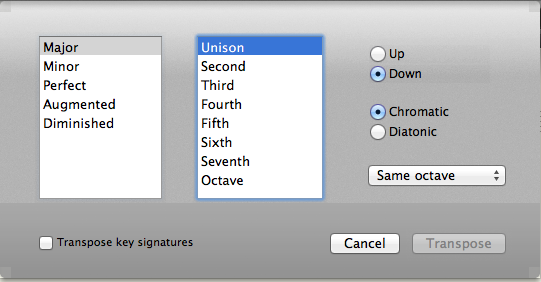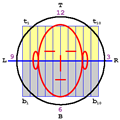The transposition in Notion seems very clumsy from a UI perspective, as compared with Sibelius, Jammer or Noteworthy.
For example, I have a piece in G-flat which I would prefer to be in G, so that it's easier for the rehearsal pianist to play. Exactly what interval would I want? It's a single semitone. On the three packages I mentioned, I can select "Go up by one semitone" and all three will do what I want and adjust the key signature accordingly.
So what interval is one semitone? A diminished second? A minor second?
Oh, I know I can go look it up on Wikipedia and figure it out eventually, but it's hard work (and I have grade 5 music theory thanks). In practice, I want one of two things:
a) Go up/down n semitones
b) Go to a specified key.
It's also weak that even if I tick the box to update the key signature, it does nothing. I have to manually go and change the key signatures. It would also be good to allow Notion to remove double flats/sharps and to use enharmonic spelling as part of transposition.
Since I have drum tracks, I don't want those transposed, but there's no easy way of omitting them, except by going into score setup, hiding them, using Ctrl-A and then transposing. Has anyone else been frustrated by the fact that the "Hide" button is right next to "Delete" (which has no "Are you sure?" option)?
I've now composed half a dozen songs on Notion and I think it's better than Sibelius (which I've used for many years), but the frequent crashes, the weird drum layout (why not MIDI?) and annoyances like transposition are pushing me towards Logic Pro.
- It is currently Thu Apr 18, 2024 7:21 am • All times are UTC - 5 hours [ DST ]
Attention:
Welcome to the old forum. While it is no longer updated, there is a wealth of information here that you may search and learn from.
To partake in the current forum discussion, please visit https://forums.presonus.com
Transposition
2 posts
• Page 1 of 1
Re: Transposition
KGrumball wrote:So what interval is one semitone? A diminished second? A minor second?
In 12-tone equal temperament, it is a minor second in NOTION 3, but you need to select the "Chromatic" option . . .
Diminished stuff basically is weird, but there are times when it is not so weird, although it depends on the specific interval, where for a second in NOTION 3 it is weird, although it should not be, since "minor" should be weird for a second . . .
This is the transposition pane in NOTION 3:

These are the selections for interval modifiers, but they are not available for all intervals:
- Code: Select all
Major
Minor
Perfect
Augmented
Diminished
And these are the intervals:
- Code: Select all
Unison
Second
Third
Fourth
Fifth
Sixth
Seventh
Octave
When I have a bit of time, I plan to explore the NOTION 3 modifier and interval algorithm toward the goal of being able to specify exactly what happens with the different combinations, since from my perspective the algorithm is a bit odd in my opinion . . .
For reference, my primary instruments are electric guitar, electric bass, piano, drums, and cowbell, although piano in some respects is more secondary . . .
When tuned correctly, all these instruments are very simple, and electric guitar, electric bass, and piano have clearly defined semitones, which for electric guitar and electric bass map to frets but for piano map to white and black keys . . .
[NOTE: In the same way that the interval between the high-pitch "g" and high-pitch "b" strings of an electric guitar is strange and causes a lot of confusion, so does the black keys being smaller and offset from the white keys on the y-axis and z-axis, although in some respects it makes playing stuff a bit easier, but so what. It no more strange conceptually than trumpets having three valves, which for reference is one of the reasons that trumpet players are a bit odd when playing diatonic scales in 4/4 time, which makes sense if you think about it for a while and is one of the reasons they tend to migrate to Jazz, Latin, and Rhythm and Blues, really . . . ]
So, like you I tend to relate to everything in terms of semitones or half-steps, which is mathematically succinct and geometrically elegant . . .
I know what I want to happen when I use the NOTION 3 Transpose tool, and in some respects I usually know which particular combination of modifier and interval to specify, but there are some combinations which either (a) do not work the way I expect or (b) are not allowed, which is a bit confusing, but so what . . .
So what!
For the most part, the unusual behaviors occur when one uses or attempts to use {diminished, augmented, perfect}, but depending on the terminology one uses this also is the case for {major, minor} . . .
In the terminology I prefer, "minor" applies to thirds, sixths, and sevenths while "diminished" does the same thing for seconds, fourths, and fifths, since the concept of a "minor second" makes little if any sense to me, as is the case for "minor fourth" and "minor fifth", . . .
So, as a general rule I use "minor" to indicate that the note is flatted, which also is the way I use "diminished", and the reality is that the only intervals which make sense with respect to being "minor" are thirds, sixths, and sevenths, because for example a "minor fourth" is a "major third", so it is weird to call it a "minor fourth", but it is not so weird to call it a "diminished fourth" . . .
[NOTE: I do not use "augmented" and "diminished" to indicate what one might call "in-between" intervals that are notes in-between two adjacent semitones. In my preferred terminology, {diminished, flat, minor} are equivalent, as are {augmented, sharp}, where the former lowers a note by a semitone, while the latter raises a note by a semitone. And I use this terminology to keep everything as simple and straightforward as possible . . . ]
An "augmented fourth" is a "diminished fifth" and both of them are pretty weird, as well . . .
Basically, the weird intervals are {second, fourth, fifth}, while the regular intervals are {third, sixth, and seventh} . . .
And for all practical purposes the only time one actually needs to use the weird modifiers {augmented, diminished, perfect} is when one cannot avoid trumpet players and other types of Jazz musicians, at which times I switch to a different terminology, where I make an effort to use the most abstruse combinations of the weird modifiers as possible, where for example I might refer to what normally is a "minor third" as being a "doubly-diminished triply-augmented perfect ninth played an octave lower for enhanced tonal coloration", which is fabulous . . .
Fabulous!
P. S. Since it is virtually trivial to play songs in different keys on electric bass and electric guitar, I do everything in music notation in the key of C entirely on the treble clef in the NOTION 3 default 4/4 time signature, since one of the great features of NOTION 3 is the ability to make the notes specified on the treble clef play either normally or one or two octaves lower or higher, which covers just about everything, because in my view of music the fact of the matter is that there are 12 notes and 8 octaves, which keeps everything very simple, as well as mathematically succinct and geometrically elegant. It also is vastly easier to remember, which is important on those days when as Shakespeare explained via Constable Dogberry's observation regarding Deputy Constable Verges, "The age is in; the wit is out" . . .
The fact of the matter is that there are 88 keys on a grand piano, and it is mathematically succinct and geometrically elegant for each key to have a grand total of one name, which is the way it works here in the sound isolation studio, for sure . . .
For sure!
P. P. S. NOTION 3 has a lot of eccentric behaviors, but there is nothing like it, and it makes excellent sense to learn as much about NOTION 3 as possible, since you can do things with NOTION 3 that cannot be done easily any other way, where the key strategy is to discover how to avoid the eccentric behaviors and mostly is a matter of (a) doing some experiments, (b) using a bit of common sense, and (c) determining whether you actually need to do something or just want to do something . . .
Explained another way, NOTION 3 probably will not do everything that you might imagine you want to do, but it will do everything that you need to do, which makes sense if you think about it for a while, really . . .
Really!
-

Surfwhammy - Posts: 1137
- Joined: Thu Oct 14, 2010 4:45 am
2 posts
• Page 1 of 1
Who is online
Users browsing this forum: No registered users and 23 guests